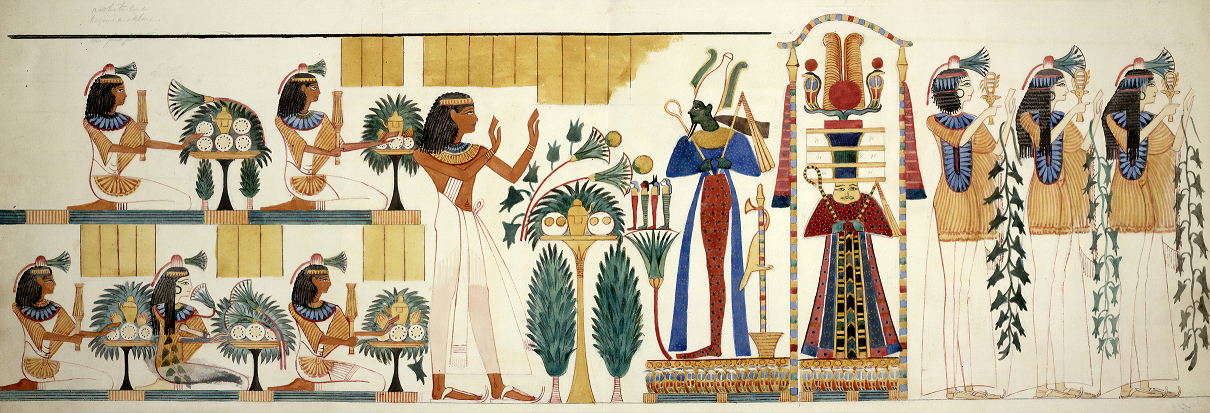Is it time to go back to the future with paper straws? The world-view is quickly changing when it comes to sustainability and environmental care. So could paper straws be the answer to the start of a new era?
The humble straw is older than the invention of paper itself. So, if we want to find out where paper straws come from (and where they’re going), we have to delve a little deeper into the history of straws throughout the ages…
Ancient Civilisation: Gold and Silver Straws
Between 6,000 to 7,000 years ago, the ancient Mesopotamians invented the very first straws – except they were usually made from wood and, sometimes, gold. The long straws were used to drink an early form of beer. Several people would drink the beer from the same receptacle, with each of them using an impressively long straw.
Long straws were particularly helpful for ancient civilisations based in hotter climates. The Ancient Egyptians, for example, frequently used straws to avoid ingesting insects that landed in their drinks.
1600s: Bombilla Tea-filtering Straws
South American natives much preferred using straws when it came to their famous yerba maté tea. The traditional, caffeinated drink is still popular today and is fast becoming a mainstay in cafés across the world. The straw, known as a bombilla, filters out the tea leaves in the drink. They are typically made from metal alloys such as bronze – or precious even metals such as gold and silver.
1800s: Straws Made from Grains
At the dawn of the 19th century, straws were commonly made from wheat and rye in many Western countries. Rye straws in particular also left a residue in the beverage and a grass-like taste. Both wheat and rye straws became soggy very quickly, making them unpopular among the public.
Marvin Stone: The Godfather of the Modern Paper Straw
Marvin Chester Stone, an American inventor, developed the paper straw, proving to be much more sustainable and consumer-friendly than his predecessors. The straws were made by winding paraffin-coated paper around a pencil, gluing the paper together and removing the pencil.
Although it sounds like a simple idea, it’s clear to see that Stone was keen to create a solution to benefit both consumers and businesses. He determined that the perfect straw length was 8.5 inches (21.5 cm) and wide enough – so debris such as fruit seeds wouldn’t get stuck.
Fortunately, Stone’s family was already renowned for making similar tubular products such as pen holders and pencil sharpeners. This meant Stone possessed the practical know-how and the business knowledge on how to manufacture paper straws in a large-scale operation.
Stone filed the patent for paper straws in 1888, and soon started to publish business-to-business adverts. The straws were marketed directly to companies, as it was an effective way to sell in bulk. Stone’s straws were made from Manila hemp originating from the Philippines. The robust Manila hemp plant was also used in the manufacturing of ship rigging and fishing nets!
In a trade advert, Stone communicated a very clear message to potential customers: “I refer to all reputable druggists in the country who use them [paper straws] at soda fountains in preference to natural straws. All first-class clubs, hotels, saloons, restaurants, etc, use my straws.”
And so the popularity of straws soared with businesses and consumers, alike. By the early 1900s, paper straws proved to be a hit. Stone promised his customers “health, cleanliness and economy,” with his straws, which reassured some of those who were concerned about catching the myriad diseases of the time. Paper straws allowed them to avoid making direct contact with the glass while drinking. At one point, Stone was producing two million paper straws a day in his factory.
He even took it one step further with the genius “double straw.” The original patent document features diagrams and a full explanation of the process.
Plastic Straws: A Short-lived Solution
Well, we say short-lived, but plastic straws pushed themselves into our everyday lives and stayed there for more than 60 years. This popularity put paper straws on the sidelines for a while.
Plastic straws seemingly appeared overnight, as the growth of fast-food restaurants created a sudden demand for disposable plastics such as drinking straws and cutlery. Novelty straws also started cropping up – such as Crazy Straws, Magic Straws and Slurpee Straws, meaning plastic straw companies were targeting children and, naturally, this normalised plastic straws as opposed to paper straws.
The biggest problem with plastic straws is that every plastic straw that has ever been produced is still somewhere on our planet. They are bad for the environment, harming sea life and contributing to the increasing levels of microplastics in our food chain.
Note: it is worth noting that flexible plastic straws are crucial for some hospital patients, as well as people living with certain debilitating conditions.
The Return of Paper Straws
We, as humans, have known about the impact of single-use plastics on our health and the planet’s health – notably the destruction of wildlife habitats, the pollution of the ocean and the build-up of litter in and around our local communities.
The push for a greener world is long overdue. McDonald’s introduced paper straws in the UK and Ireland last year and completely phased out plastic straws. Dutch-based company FrieslandCampina has switched to paper straws for all packaging for its European products. The company’s Global Director of Packaging Development, said: “We will replace 142 million straws, which is more than 23,000 kilometers and 57,000 kilos of plastic.”
It appears Marvin Stone was partly right in the 1800s when he included a tagline in his adverts claiming:
“If you try them [paper straws] once, you will use them always.”
After decades of non-biodegradable plastic straws playing havoc with our environment, it seems paper straws are finally returning to the spotlight again.
The Present and the Future of Paper Straws
Paper straws are emerging again as a contender, especially with many countries set to impose an outright ban on plastic straws. Tembo Paper’s straws, for example, prioritise user experience. This means our paper straws are tasteless, odourless, and smooth to the touch. We are able to manufacture various types of straws such as the classic straight straw, the U-shape straw and the telescopic straw.
One of the biggest hurdles with regards to paper straws is durability, though that is dependent on the manufacturing process of the straw. At Tembo, we use 120 gsm biodegradable paper for our straws, which is reassuring for consumers as the straws can last up to four hours while submerged in liquid. So, not only are Tembo Paper’s straws environmentally-friendly, they’re designed with consumers in mind.
Photo by British Library on Unsplash


